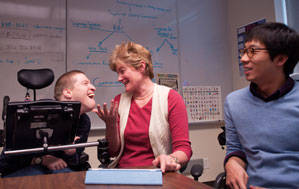Giving Voice to the Silent
(Note--this story comes from the Indiana University Foundation's Spring 2013 issue of "Imagine," available online here.)
Call him silent, if you will. He’s eight years old, withdrawn, not interested in communicating. IU researchers place an iPad in his hands. It’s loaded with a voicing application designed for kids with severe communication challenges. In a short time, the uncommunicative youngster communicates through symbols that the iPad is “my stuff.” For the first time in his young life, he has a voice.
The experience epitomizes the work of Professor Erna Alant, who holds the Otting Chair in Special Education at the Indiana University School of Education in Bloomington.
“There is no more devastating loneliness than that experienced by people trapped in their own bodies, unable to communicate to those closest to them,” says Alant, an expert in augmentative and alternative communication (AAC). “And nothing is more rewarding than helping them to find their own voice.”
For the past 28 years, Alant has given people with little or no speech a chance to interact with the world by using nonverbal strategies.
South Africa-born, Alant was inspired by the work of Professor Lyle Lloyd, a Purdue University researcher. With his model in mind, Alant founded the Centre for Augmentative and Alternative Communication at the University of Pretoria. The centre trains teachers and parents to help children and adults with complex communication difficulties, employing low-tech means, such as symbols and gestures, and high-tech devices, such as computers and the Internet.
Just five years after its creation, the centre received the Education Africa Presidential Award from Nelson Mandela. During nearly 20 years of Alant’s leadership, it earned many other prestigious awards, including the Rolex Award for Enterprise in 1998. In 2005 she reconnected with Professor Lloyd to co-edit a groundbreaking volume, Augmentative and Alternative Communication and Severe Disabilities: Beyond Poverty, the first book to focus on poverty and AAC intervention internationally.
In 2009 Alant’s career moved to Bloomington, when she accepted the Otting Chair. The late Edward Otting and his wife, Mary Lou, had a deep interest in the education of children with disabilities. They established the chair and an associated research fund in 1998.
In just a few years, Alant has grown IU’s AAC program by collaborating with the IU Department of Speech and Hearing, the Indiana Institute on Disability and Community, the Monroe County Community School Corporation (MCCSC), and communication technology manufacturers.
“My premise is that no one is too disabled to communicate,” Alant stresses. “You just need to find a way for them to express themselves using the abilities they do have.”
Her work continues to change lives. She recently invited one of the most distinguished AAC interventionists in the country, Gail van Tatenhove, to visit MCCSC classrooms to assist children with severe communication problems. Van Tatenhove used basic communication boards and manual signs to help the children participate in storytelling. Parents and teachers were in awe when children with little or no speech capability took part. The kids quickly grasped how powerful symbols are in helping them get their messages across.
“When Dr. Alant joined our faculty as the Otting Chair, we knew her work was visionary,” says School of Education Dean Gerardo Gonzalez. “She is giving voice to those with severe communication disorders. She is committed to preparing teachers who think as she does: that when something seems impossible, you just need to work harder to find what possibilities exist.”
The Ottings’ gift made voice-giving possible through the work of Erna Alant. Imagine what your own philanthropy could do.
For more information about this or any other School of Education giving opportunities, contact Jonathan D. Purvis, executive director of development and alumni relations, at jpurvis@indiana.edu or 812‑856‑8021.
 Professor Erna Alant (center) sits with an IU graduate student and a person who uses augmentative and alternative communication.
Professor Erna Alant (center) sits with an IU graduate student and a person who uses augmentative and alternative communication.